No matter whether you are building a SaaS or any other business – it’s always full of challenges and a lifelong learning process. It’s been the same for us at EmailOctopus.
We generally don’t talk much about our journey, apart from a couple of times when we have hit significant milestones – we’re too busy building functionality and working on the business. It’s now been 9 years since our first line of code was written, since then we’ve grown EmailOctopus to generate millions in revenue per year without any external funding.
So what better time to share and discuss some of the marketing tactics we’ve doing along the way.
Free growth efforts in the early days
When we first started EmailOctopus, we had very little money. Any recurring revenue generated was funnelled towards our own living costs, having either left our previous jobs or reduced hours. This led to us looking to innovative, free tactics to generate interest in the busy email marketing space.
Using Quora to get the word out
One of the first things that we did while getting the EmailOctopus name out was answering questions on Quora.

We found that there were many people who were either asking questions in our niche or following existing ones to get an answer. Capitalising on this was rather easy, as we had to only find and answer user questions.
Back when we launched, Quora also had a piece of functionality called Answer Wiki’s. Answer Wiki’s were summarised answers, placed just below the question – so the top visible item. It was in the days prior to AI, so these summarised answers were written by the community. What we’d spend a lot of time on, rather than just answering questions was summarising the existing ones. So when someone would ask “What is the most affordable email marketing platform?”, we’d summarise all the existing answers mentioning our competitors. And we’d also slip in our own brand.
When you’re starting out with a small audience, leveraging quirks and functionality in existing prominent websites is the perfect way to grow.
This helped us get the first set of customers on EmailOctopus.
Reddit promotions
Just like Quora, Reddit was our other source of traffic in the early days. With little to spend on paid advertising, making use of active subreddits like /r/marketing and /r/entrepreneur was a way for us to learn, share our expertise and also promote our business where appropriate.
Reddit, as everyone knows, is a tough crowd, which is what makes it such an engaging community. It feels free of advertising and commercialisation, so we made sure to embed ourselves and understand the communities before mentioning our product.

And when Mailchimp made a drastic price increase 4 years ago, we jumped on it. Not to promote EmailOctopus, but to inform the community on what those changes meant.
Building side projects
Building side projects also contributed to a big chunk of traffic, referrals and brand recognition.
In 2017, as we built our drag and drop editor, we began designing email templates for it. With a touch of serendipity, that same week someone launched their own paid email templates on Product Hunt and reached No.1 for the day.
That led us to think about releasing our own templates, completely free and open sourcing them. That was our first side project, templates.emailoctopus.com (or the more wordy “Free Email Templates by EmailOctopus”).
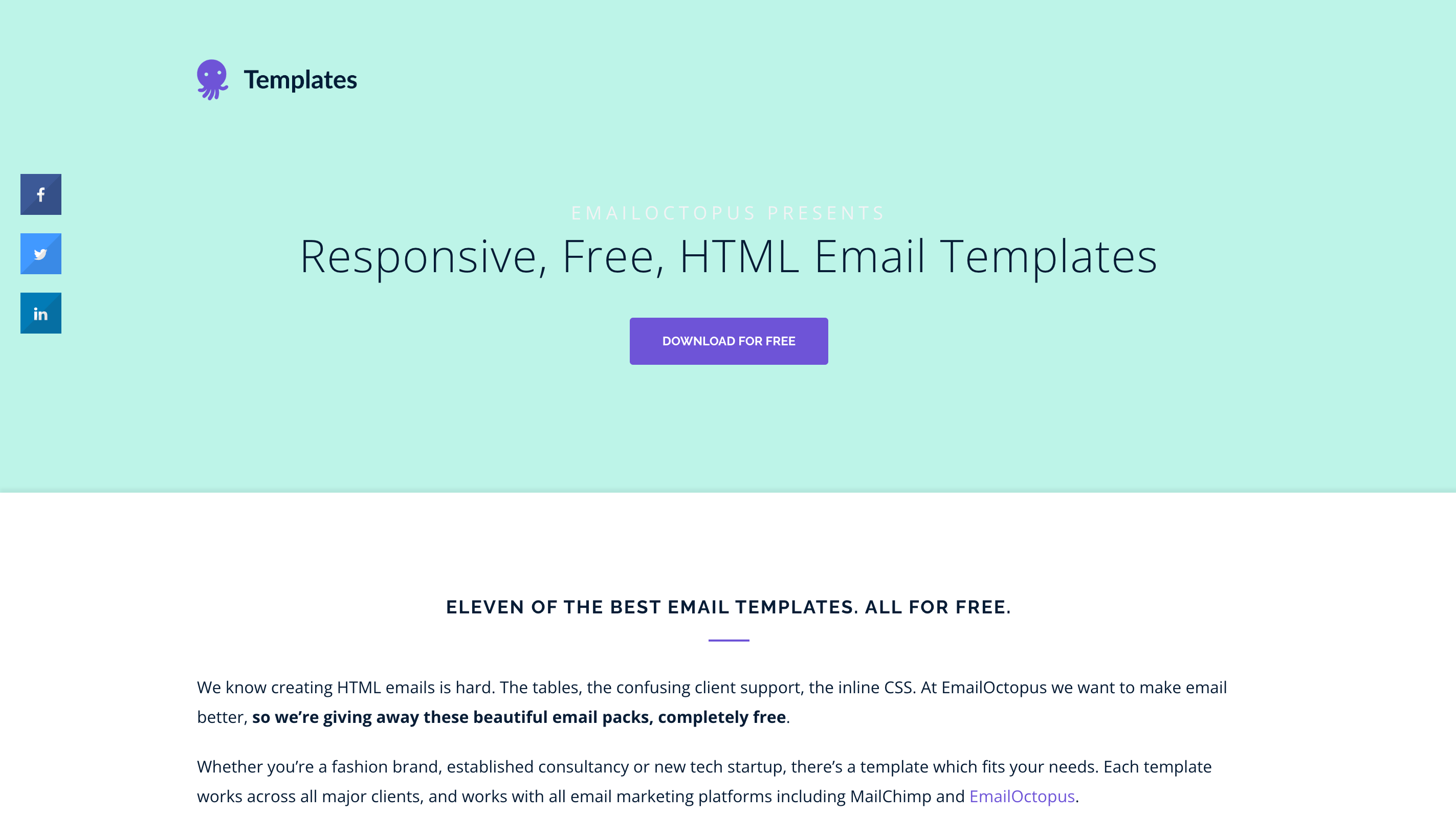
It was essentially a set of free HTML email templates made by a designer which was compatible with all ESPs. To download these email templates, users would have to submit their email, which we later used to let them know about EmailOctopus. From this side project alone, we generated over 50,000 signups ranging from small businesses up to companies such as Uber.
The website still exists – probably still feeling a bit 2017 – but that launch led to backlinks from websites like Hubspot and massively increased our brand recognition.
Another popular side-project by us was a GitHub repository about email marketing regulations, which we launched around the time the GDPR was being heavily discussed. That project has been starred over 400 times on Github and cements our position as a responsible email provider.
Paid channels
As EmailOctopus grew beyond $10k MRR, we begun to look at how we could reinvest some of the funds generated in paid channels.
Sponsoring newsletters
Over the years we’ve also sponsored a variety of newsletters including as No CS Degree, Landing Letter, The Slice and Dense Discovery.
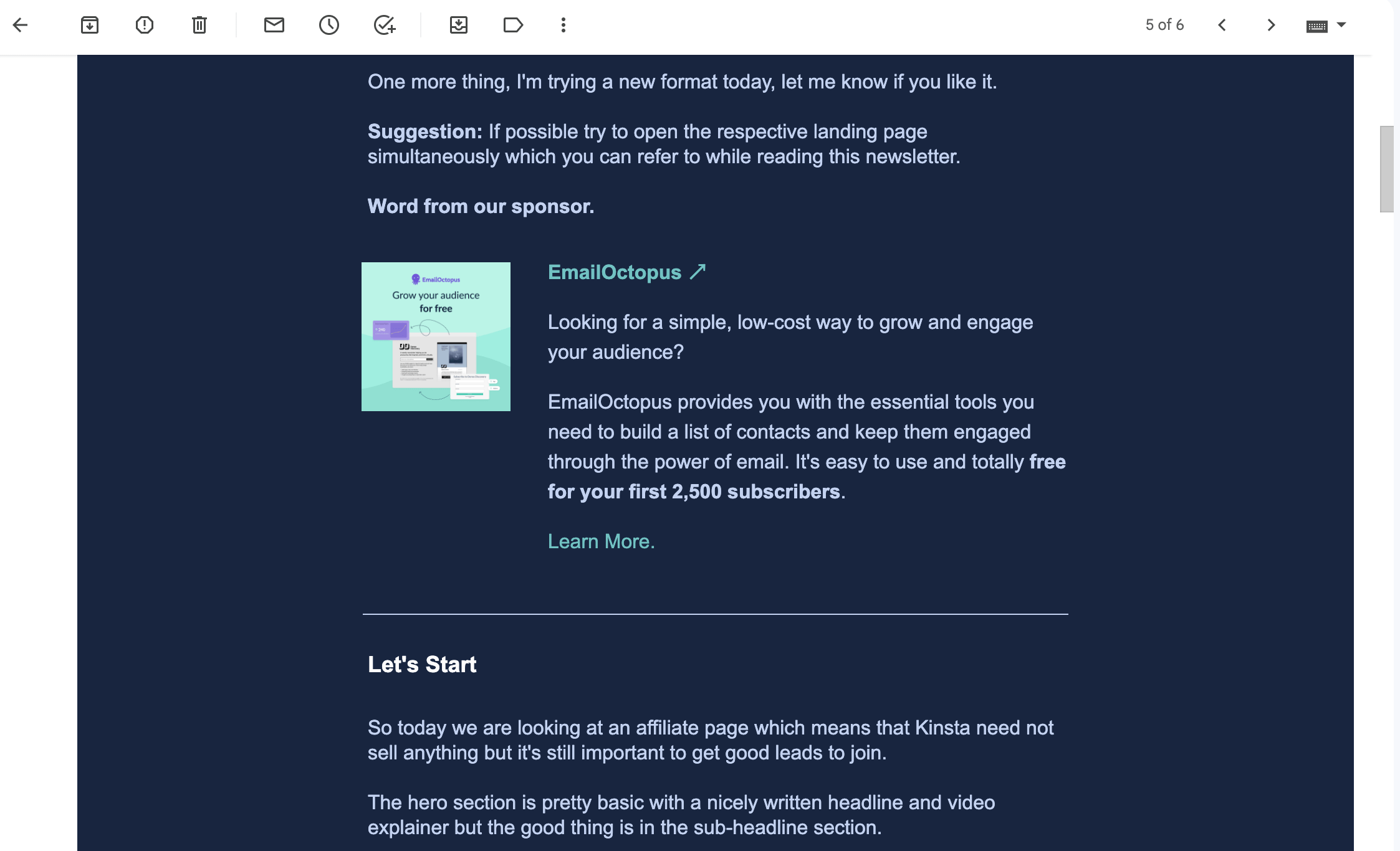
The issue with newsletter sponsorship, is that from a buyers perspective they are difficult to attribute success to. There are very few clicks on them. As a primarily B2B product, it’s also the case that buying decisions for tools like EmailOctopus are generally done on a lot of research and thought. Rarely being an impulse purchase.
The hope is newsletter ads, even though they don’t work for us at an attribution level. May help in brand awareness, which may lead to conversion later. It’s also the case that longer term partnerships are more likely to resonate and be remembered by readers. Placing an ad in a single newsletter and hoping for it to bring significant, attributable, rewards, in our experience is wishful thinking.
Sponsoring Marketing Examples
Sponsoring Marketing Examples was another unique opportunity that we came upon when Harry Dry was building a website and newsletter about marketing examples and small case studies.
It was a marketing bet, made after meeting Harry at a local meetup and him explaining some of the amazing marketing stunts he’d pulled – such as The Kanye Story.
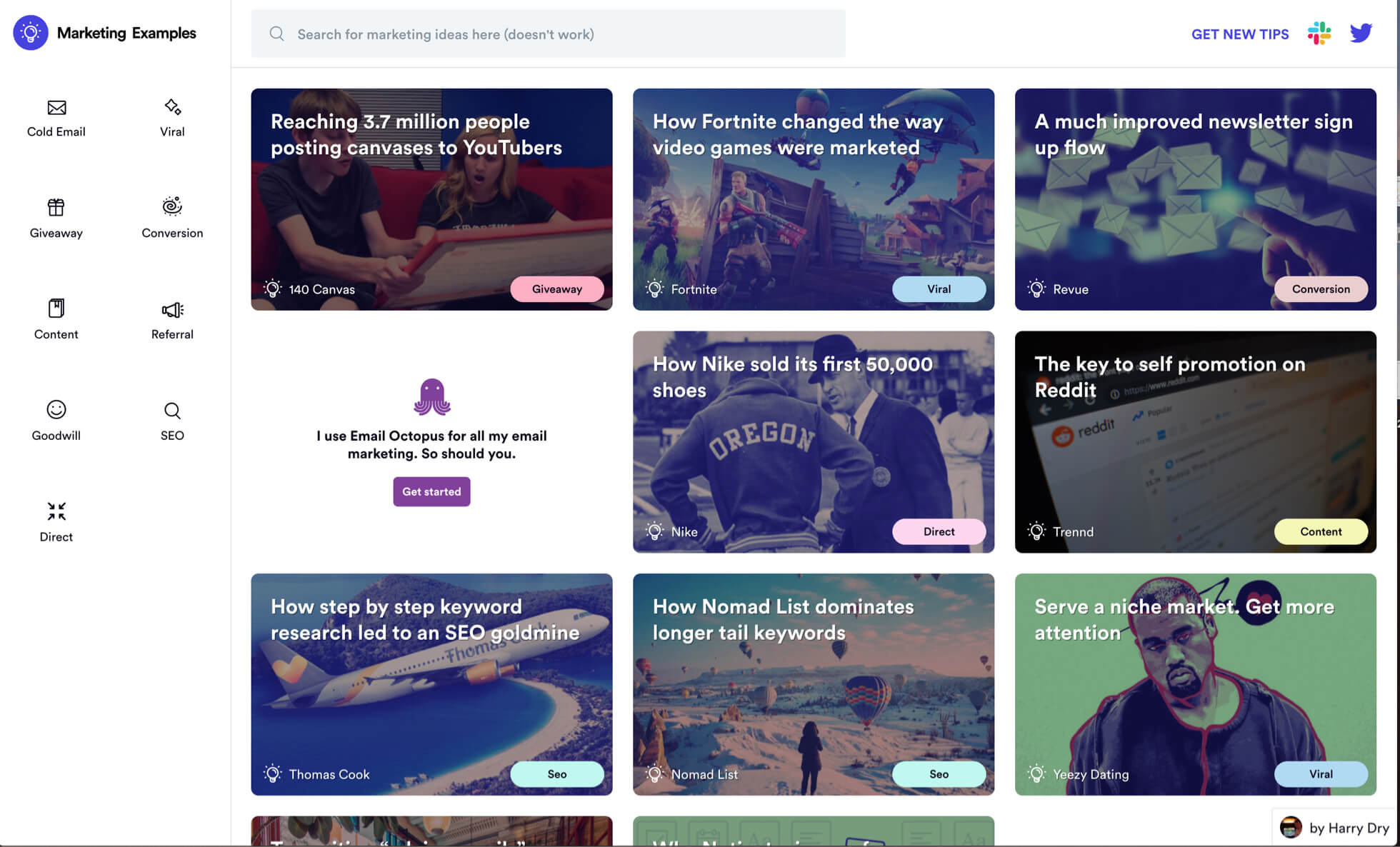
On the walk back from the meetup, I agreed to hear Harry out on the bet. And the next day we agreed £2000 for the first 3 months of sponsorship for Marketing Examples. It was a website, which at that time didn’t really yet exist.
Harry pitched it as “ think of Sir Alex Ferguson snapping up a young, skinny, energetic, Cristiano Ronaldo from Sporting.” And in his Sir Alex like excellence, made it a complete hit, where today it has hundreds of thousands of readers and email subscribers.
Even today, we have people signing up who mentioned that they heard about us on Marketing Examples. Because we were there during the initial excitement and the launch, people still associate the brand – even though the sponsorship campaign ran for little more than 6 months (before we got blown out of the water by AHREFS making a huge sponsorship offer).
Google Ads
Google Ads are now at a point where they’re an essential for businesses, often for their defensive positioning. Email marketing is a highly competitive market, so bidding on generic terms such as “Email marketing” costs around $25 per click for what is a non-targeted term. It could be anyone googling that, whether they’re looking for a platform to use or just wanting to learn more about marketing.
Higher intent keywords, like “Mailchimp Alternative” are also highly competitive. There are hundreds of email marketing platforms bidding for that keyword, and it can cost upwards of $30 per click.

As a result, we primarily use Google Ads as a defensive position. Primarily to prevent competitors from bidding on our brand keywords. The cost per click (around $4) of doing so is frustrating, but it’s important we defend our brand.
We do also run slightly longer tail, intent led, keywords like “Cheapest alternatives to Mailerlite”. It’s a more specific phrase on a less well known competitor, meaning it’s more affordable.
Overall we spend around $15,000 per month on Google Ads, with conversions coming at around $80 each. It’s something we’re limited in expansion on, as while we could bid on more keywords the intent becomes less and the cost becomes more expensive. Our focus is on ensuring the lifetime value of a customer exceeds acquisition costs by at least a factor of 3.
Redesigning the EmailOctopus landing page
Having a strong brand is the best ‘hack’ to growing a business over time. With a memorable name and cute mascot, I cannot count the amount of times people have seen our logo (either in an ad or on the bottom of a newsletter) and recalled it months down the line. Our logo, colour scheme and branding is something we’ve invested a lot of energy on creating. A memorable logo doesn’t cost much though, our original logo cost $5 on Fiverr!
In 2019 we resigned our landing page and refreshed the brand. It was a moment where we seriously began to define the brand and how we wanted to be seen. In an industry full of SendInBlues, Salesforces, Omnisends and ActiveCampaigns, we wanted to be seen as fun and a little quirky. Targeted at small businesses, rather than the corporates who seem to love a dreary blue colour scheme and a forgettable name.
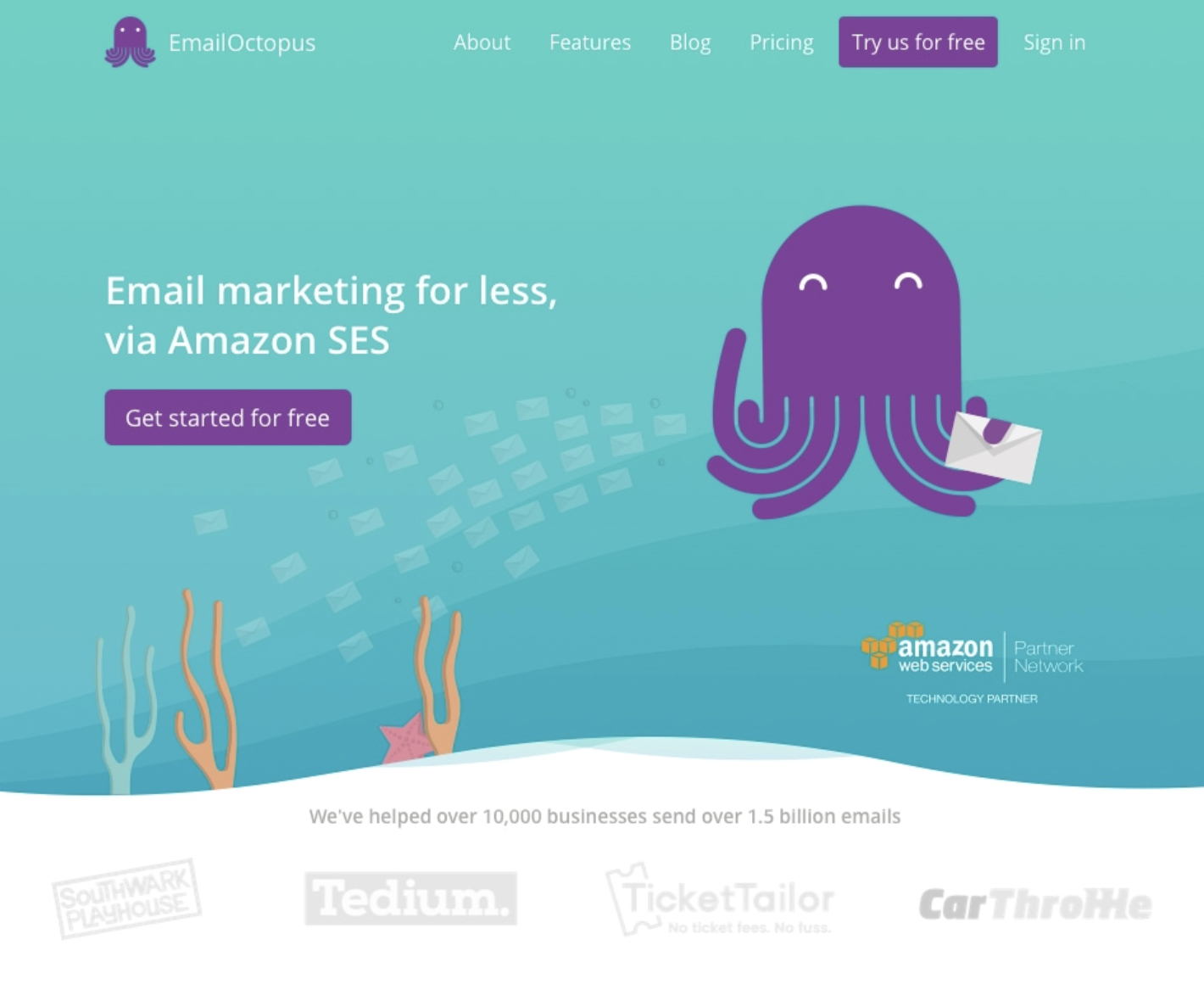
Our sign-up rate post change is around 15-16%. It wasn’t a significant jump forward, but the positioning and memorable-ness has definitely contributed towards our success.
Leveraging existing customers
Launching an affiliate program
At EmailOctopus, we also worked towards building our own affiliate system with the theory that users would sign up and would then refer us to their network, which would lead to generating another growth channel for us.
Affiliate programmes generally are a lot of work. We have had affiliates creating fake accounts to create revenue, and we’ve also seen affiliates contravening our policies by bidding on our own brand name on Google. The management of this takes time, but could be worthwhile if you develop it as a channel. In our case, we’ve yet to find it working on a consistent basis.
As it stands around 3% of our revenue comes from those referred by affiliates, meaning each month we pay less than $3,500 to our affiliates. We have over 1,000 affiliates signed up but only 2 of our affiliates drive 90% that revenue.
If we were to start again, knowing what we know now. We would not build or launch an affiliate programme, the management and monitoring exceeds the worth of the meaningful and legitimate traffic we see each month. With it built though, we do have an ongoing committment to our affiliates – so we have no plans to remove it as a channel at this stage and it’s something we may retry with more effort in the future. Like any channel, it’s impossible to say it’ll never work – rather the implementation we have at present isn’t working for us. Time or a change of implementation may see that change.
Encouraging reviews
Another marketing strategy that we have in place is to get more user reviews across the web. We know word of mouth is crucial to us growing sustainably, so to encourage the sharing of experiences we encourage and offer incentives (where allowed) users to leave their reviews on Capterra, Crozdesk, Facebook or AlternativeTo.
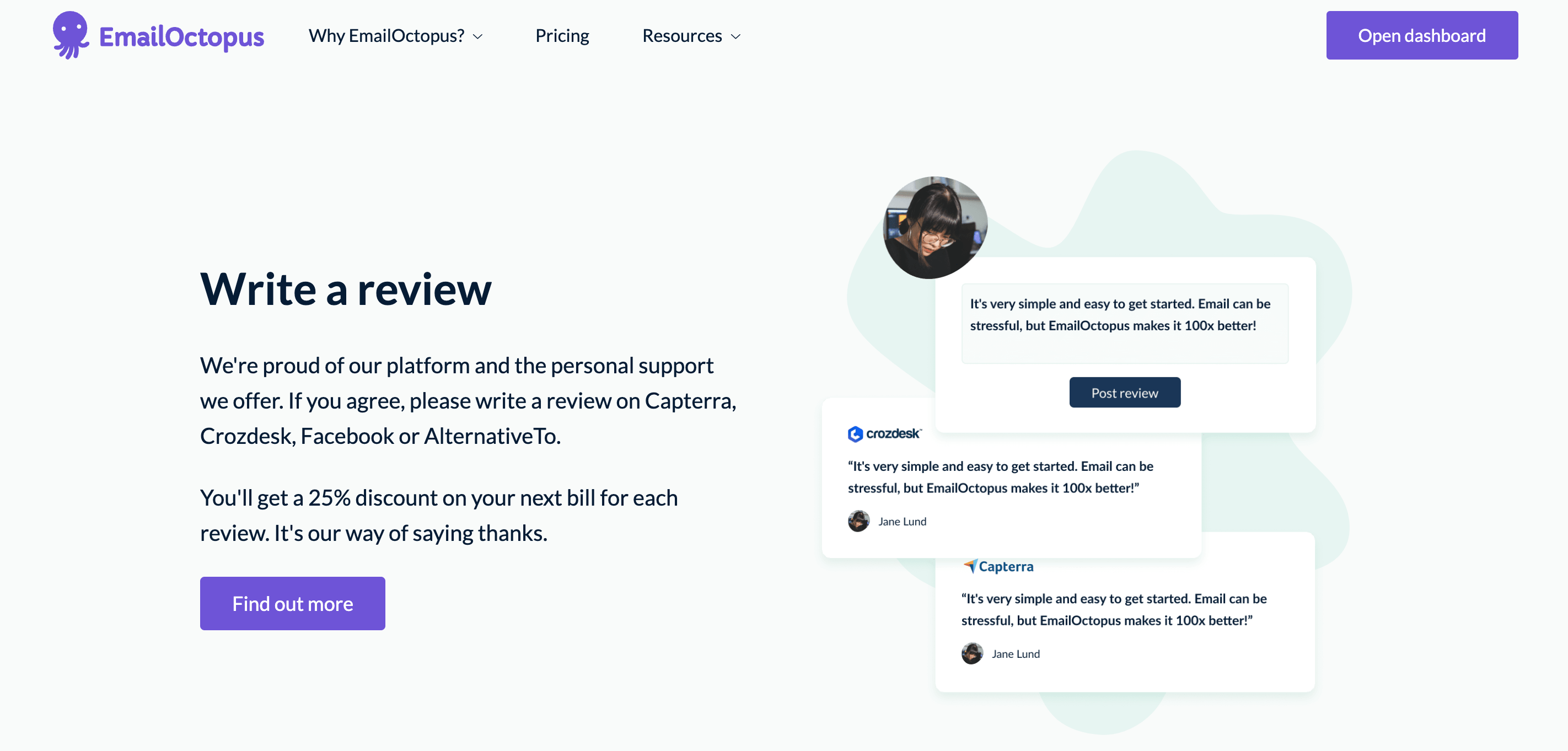
These incentives are usually in the form of a 25% one-off discount, or in the case of Capterra a $20 – offered to the user by Capterra themselves. We promote the leaving of reviews following a positive interaction on Support or following NPS feedback being left within the platform.
Our number one review website is Capterra, which has over 300 reviews. Interestingly a $20 gift card offers a customer much more incentive to leave a review, than a saving of up to $250 on their plan. Offering someone something tangible – money or a gift – is a much stronger psychological pull than offering them money off a future payment.

Reviews are one of those things which we cannot immediately attribute revenue to, however we know positive reviews are an important driver to prospective customers, weighing up their next marketing tool.
Sponsoring IndieHackers and Indie Bites
Our most recent big advertising spend has been on two ‘Indie’ websites. Our first was on Indie Bites, a podcast set-up by fellow London-based founder James McKinven. We have sponsored his podcast for the next 50 episodes at a cost of £275 per episode. It’s too early to mention any success, but we were keen to support James on his work and without the sponsor, there was a risk the podcast (which is well listened to by the independent business community) would fail. It’s always more pleasing to spend money on supporting fellow founders than sending it to Google or Microsoft and we hope will be some value, not least in the form of karma, coming our way.
The next spend was on the Indie Hackers newsletter. Indie Hackers is a community we’ve been part of for a long time, first featuring on their podcast in 2018 and doing an AMA for their readers as recently as 2021.

When the opportunity came about to sponsor their newsletter, it was something we were keen to try out – there’s something about supporting good people working on good projects. So we spent $1,000 for 2 prominent positions inside their newsletter.
Ultimately, like most of our newsletter efforts it wasn’t an overwhelming success and presented only 58 clicks.
If we started again
If starting again, we’d take a similar approach to building a business. It is very easy to spend thousands of pounds chasing users via advertising, and with much of that spend hard to attribute it’s a huge risk for any small self-funded business. As a bootstrapped startup, every penny we spend is a penny which could be spent by us elsewhere – whether that’s on our personal lives (mortgages to pay) or business expenses. Making the use out of lower financial risk channels is therefore incredibly important. SEO and content being a great place to start, alongside any of the other channels we have tried.
Community is one place to start, and not building out your own community and audience. Instead utilising others which already exist. Here’s the playbook:
- Identify segments of customers who would use, and pay, for your product. An example for us is those with a large email contact list, but who can’t attribute revenue directly to that email list (so cost is key). Self-published authors or musicians, is an example of this.
- Sign up to communities where those people hang out. There’s likely hundreds of communities on Facebook as well as dedicated websites and forums catering to specific interests.
- Spend time absorbing yourself into that group. No promotion, just understanding their issues. Doing so will improve your product and knowledge of the area.
As always, though, non-technical people will run into issues you know about. So even if your product doesn’t solve those issues – contribute, help, recommend, and build a name for yourself as a contributor and member of the commnuity. - Once your presence is established, perhaps a month or so in (depending on how active the community is) update your profile to share what you work on and how it can solve their problems. Begin gently promoting your product if people have issues which it solve.
- People will, in time, begin to switch across – they know you and trust you. Once you have 10 active community members using your product, your job is done. They’ll promote your product. The cycle continues. Use of your product grows, and the community is yours.
Not only does this help your business grow with little ad spend, it helps you understand your segment and their needs better.
It’s a tactic perfect not only for marketing, but for product development.
Conclusion
So this has been our marketing journey at EmailOctopus so far, a journey which has seen over 120,000 people sign up to use the service. Hopefully there’s some value and context for growing your own business, and some tactics which you may apply.
Of course, if you are looking for an affordable email marketing tool, then sign up for our industry leading free plan where you can email 2,500 contacts for free.



No Comments
Leave a comment Cancel